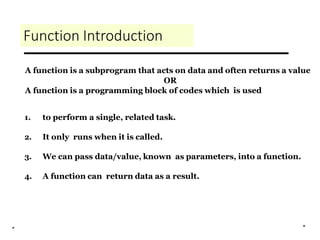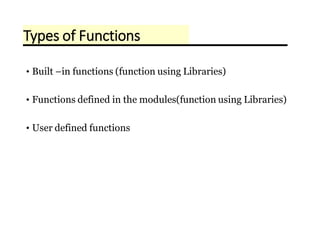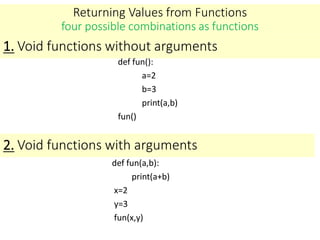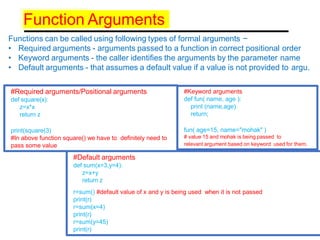1. A function is a block of code that performs a specific task and can be called anywhere in a program. Functions make code reusable, improve modularity, and make programs easier to understand.
2. There are three main types of functions: built-in functions, functions defined in modules, and user-defined functions. Built-in functions are pre-defined and always available, module functions require importing, and user-defined functions are created by programmers.
3. Functions improve code organization and readability by separating code into logical, modular units. Functions can take parameters, return values, and be called from other parts of a program or other functions. This allows for code reuse and modular programming.






![String functions:
Method Description Syntax
capitalize() Converts the first character to upper case str.capitalize()
center() string padded with specified fillchar. str.center(width,[fillchar])
#Width means length of the string
count() Returns the number of times a specified value
occurs in a string
str.count(substring,[start], [end])
endswith() Returns true if the string ends with the
specified value
str.endswith(substring,[start],[end])
format() Formats specified values in a string print("Hello {}, your rollno {}.".format(“abc", 23))
print("Hello {name}, your rollno {rn}.“
.format(name=“abc", rn=23))
find()
Searches the string for a specified value and
returns the position(index) of where it was
found
str.find(sub,[start],[end] )
index()
Searches the string for a specified value and
returns the position of where it was found
str.index(sub,[start],[end] )
The only difference is that find() method returns -1 if the substring is not found, whereas index() throws an exception.
Functions using libraries(System defined function or Built- in Functions)](https://image.slidesharecdn.com/functionspptpdf-240219152006-2ba2adf7/85/Chapter-Functions-for-grade-12-computer-Science-7-320.jpg)






![Creating a Function (user defined)
A function is defined using the def keyword in
python.
def <function_name>([arguments/parameters]):
[“”” function’s docstring “””]
<statement>
[statement]
[statement]
:
:
Function block/ definition/ working of the function
def fun():
print("Hello")
print(“world”)
e.g.
Syntax: Name of the function
colon at the end means it requires a block
def
means
function
definition
is starting
arguments/parameters-means values given to function
def cals(a):
b=2*a
print(b)](https://image.slidesharecdn.com/functionspptpdf-240219152006-2ba2adf7/85/Chapter-Functions-for-grade-12-computer-Science-14-320.jpg)




























![Passing mutable type value to a function
e.g.
def fun(a):
print(a)
a[0]=1
print (a)
n=[3,5,6]
print(n)
fun(n)
print(n)
Output
3,5,6
3,5,6
1,5,6
1,5,6
Value changed in function change the value in main program(because list
change values at same address and only single value is changing)
CASE-1](https://image.slidesharecdn.com/functionspptpdf-240219152006-2ba2adf7/85/Chapter-Functions-for-grade-12-computer-Science-43-320.jpg)
![Passing mutable type value to a function
e.g.
def fun(a):
print(a)
f=[7,8]
a=f
print (a)
n=[3,5,6]
print(n)
fun(n)
print(n)
Output
3,5,6
3,5,6
7,8
3,5,6
Value changed in function did not change for main program(because a is
assigned a whole new list not a change of single values for whole
program
CASE-2](https://image.slidesharecdn.com/functionspptpdf-240219152006-2ba2adf7/85/Chapter-Functions-for-grade-12-computer-Science-44-320.jpg)
![Pass Mutable type values to a function
Arrays are popular in most programming languages like: Java, C/C++, JavaScript and
so on. However, in Python, they are not that common. When people talk about Python
arrays, more often than not, they are talking about Python lists. Array of numeric
values are supported in Python by the array module.
e.g.
def dosomething( thelist ):
for element in thelist:
print (element)
dosomething( ['1','2','3'] )
alist = ['red','green','blue']
dosomething( alist )
OUTPUT:
1
2
3
red
green
Blue
Note:- List is mutable datatype that’s why it treat as pass by reference.It is
already explained in topic Mutable/immutable properties of data objects w/r
function](https://image.slidesharecdn.com/functionspptpdf-240219152006-2ba2adf7/85/Chapter-Functions-for-grade-12-computer-Science-45-320.jpg)
![Mutable/immutable properties of data objects w/r function
How objects are passed to Functions
#Pass by reference
def updateList(list1):
print(id(list1))
list1 += [10]
print(id(list1))
n = [50, 60]
print(id(n))
updateList(n)
print(n)
print(id(n))
OUTPUT
34122928
34122928
34122928
[50, 60, 10]
34122928
#In above function list1 an object is being passed
and its contents are changing because it ismutable
that’s why it is behaving like pass by reference
#Pass by value
def updateNumber(n):
print(id(n))
n += 10
print(id(n))
b = 5
print(id(b))
updateNumber(b)
print(b)
print(id(b))
OUTPUT
1691040064
1691040064
1691040224
5
1691040064
#In above function value of variable b is not
being changed because it is immutable that’s
why it is behaving like pass by value](https://image.slidesharecdn.com/functionspptpdf-240219152006-2ba2adf7/85/Chapter-Functions-for-grade-12-computer-Science-46-320.jpg)